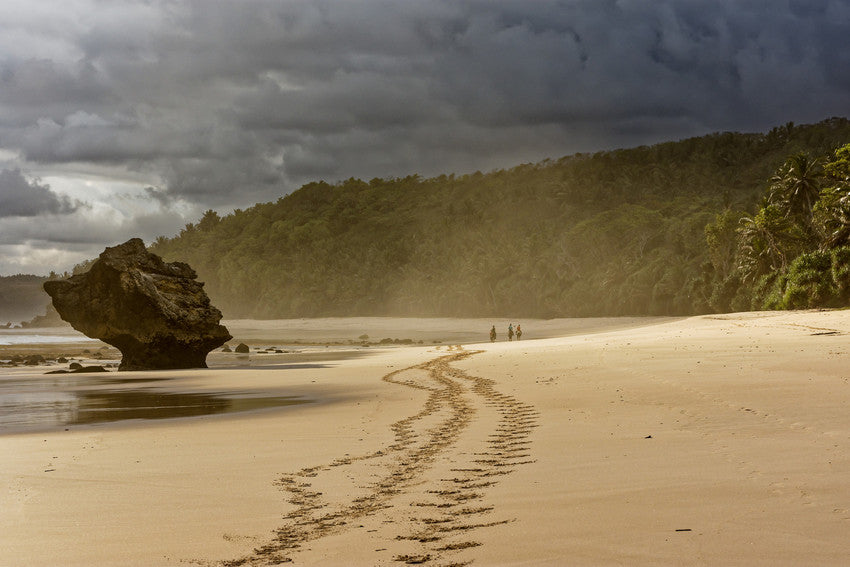MASTER OF CRAFT
A LOOMING LEGACY
SUMBA, INDONESIA
Scroll to explore
The Story
IN CONVERSATION WITH PEDA WEI AWANG AND DIALA RADE
IKAT WEAVERS IN SUMBA, INDONESIA
Peda Wei Awang and Diala Rade are ikat weavers from the island of Sumba in Indonesia. Ikat weaving is a daily part of life where the tapestry-like fabrics, whether in simple color stripes or more elaborate symbolic designs, are worn as garments, carried as family or village crests, gifted during celebrations and more recently traded with visitors to the island. The island weavers typically produce double ikat which is considered to be the most difficult to design and most highly valued.

It has
DIALA RADE, IKAT WEAVER
a uniqueness to it that
modern clothes do
not have.
S+O — ARE IKATS WORN IN DAILY LIFE IN SUMBA?
Awang — Generally, the elders in the villages will still wear ikats in daily life, even when they are carrying out activities like farming, feeding the cattle, weaving, cooking or washing. Personally, as a woman, I wear a sarung with a top. I would never wear pants or other modern clothes, because I find them uncomfortable.
S+O — HOW DOES IKAT PLAY A ROLE IN THE CEREMONIAL ASPECT OF YOUR CULTURE?
Awang — Ikats have many uses in our culture. They are worn in local ceremonies and festivities, whether a party celebration or a funeral. Ikats are also gifted during special events. Additionally, we have a tradition that calls for a newlywed woman to bring a chest full of sarungs, which are ikats for women, when she moves into her husband’s home.
S+O — WHOSE ROLE IS IT TO MAKE IKAT, A MAN’S OR A WOMAN’S?
Rade — All Sumbanese women should know how to weave. Weaving is one of the most basic skills that a woman should have in our culture. We believe that it is a sign of successful parenting when a daughter can weave well.

S+O — HOW LONG DOES IT TYPICALLY TAKE TO MAKE ONE?
Awang — Depending on the type of ikat, we follow different processes necessary to produce them. Generally, we make two versions of ikat, the sarung and the kain. A kain is a garment made for men. It’s larger, so it takes more time to weave it than a women’s sarung. If we work seven to eight hours per day, we can make a sarung in two weeks. A kain would take at least a week longer than that.


S+O — WHAT CULTURAL SYMBOLS OR DESIGNS ARE WOVEN INTO THE IKATS?
Rade — There are many different cultural symbols represented in the ikat designs, such as our traditional houses, animals, like the horses found here, or flowers. Every symbol has its own meaning. Mamuli is a worm-like metal ornament that represents fertility. Sumbanese women often wear this symbol. The designs of traditional houses represent the identity of the local people. Sumba’s horses are called Sandalwood ponies named after the sandalwood trees which were harvested here for many years.
S+O — WHAT, IF ANY, CHANGES ARE TAKING PLACE ON THE ISLAND THAT HAVE AN IMPACT ON THE WEAVING TRADITION?
Awang — In the past, we didn’t attend school because it was very expensive, instead every Sumbanese woman learned to weave. Nowadays, the younger generation attends school and prefers more modern professions. But we still believe it is very important to continue to teach the practice of weaving.


S+O — WHY IS IT IMPORTANT FOR THE YOUNGER GENERATION TO CONTINUE THIS WORK?
Rade — It is essential to preserve our culture. The livelihood of our community is still dependent on it. It’s a way to make a living. Even though things are changing and the younger generation wears modern clothes, I firmly believe that ikat has its own place here and the art form will never die. It has a uniqueness to it that modern clothes do not have.

Credits
Photography by Tânia Araújo
Film by Chris Low
Special Acknowledgments - Elissa Lumley and Antonella Mascimino of Nihi Sumba
The Objects
Exclusive Edition 023 Sumbanese Ikat Fabrics
Double weave ikat is traditionally made by three cultures in the modern world - Japan, India and Indonesia. Sumbanese ikats are considered to be the most sought after of the Indonesian version of the craft. These woven fabrics are made by the women of the island in a lasting legacy passed down from mother to daughter. The ikats continue to play an important role in Sumbanese society, either in the form of worn garments, in daily or ceremonial life, or more recently as a means of commerce with the outside world.
The Destination
SUMBA, INDONESIA
The enchanting island of Sumba is one of the most authentic Indonesian island cultural experiences still in existence. The part-Christian, part-Animist worshipping inhabitants live mostly in traditional villages with stick and palm built houses and with subsistence farming practices. In recent years, the island has begun attracting adventurous travelers seeking a gentler pace and wilder Indonesian experience than overrun Bali thanks to Nihi Sumba, a luxury resort twice voted as Travel & Leisure’s Best Hotel in the World. Nihi is the island’s first and, as of now, only resort founded originally as an upscale surfer’s retreat due to the world-class waves found nearby. Now as a widely touted destination, it is working to simultaneously improve the lives and livelihoods of the island natives by training and employing them as staff as well as providing education, clean water and medical clinics through its Sumba Foundation.



